[English] 日本語
 Yorodumi
Yorodumi- PDB-4rjf: Crystal structure of the human sliding clamp at 2.0 angstrom reso... -
+ Open data
Open data
- Basic information
Basic information
| Entry | Database: PDB / ID: 4rjf | ||||||
|---|---|---|---|---|---|---|---|
| Title | Crystal structure of the human sliding clamp at 2.0 angstrom resolution | ||||||
 Components Components |
| ||||||
 Keywords Keywords | REPLICATION / sliding clamp / processivity factor / p21 / DNA polymerase / Nucleus | ||||||
| Function / homology |  Function and homology information Function and homology information: / negative regulation of cyclin-dependent protein kinase activity / negative regulation of cardiac muscle tissue regeneration / negative regulation of DNA biosynthetic process / FOXO-mediated transcription of cell cycle genes / TFAP2 (AP-2) family regulates transcription of cell cycle factors / cellular response to cell-matrix adhesion / positive regulation of deoxyribonuclease activity / dinucleotide insertion or deletion binding / PCNA-p21 complex ...: / negative regulation of cyclin-dependent protein kinase activity / negative regulation of cardiac muscle tissue regeneration / negative regulation of DNA biosynthetic process / FOXO-mediated transcription of cell cycle genes / TFAP2 (AP-2) family regulates transcription of cell cycle factors / cellular response to cell-matrix adhesion / positive regulation of deoxyribonuclease activity / dinucleotide insertion or deletion binding / PCNA-p21 complex / mitotic telomere maintenance via semi-conservative replication / regulation of cell cycle G1/S phase transition / import into nucleus / Transcriptional regulation by RUNX2 / purine-specific mismatch base pair DNA N-glycosylase activity / tissue regeneration / nuclear lamina / positive regulation of DNA-directed DNA polymerase activity / Polymerase switching / MutLalpha complex binding / Telomere C-strand (Lagging Strand) Synthesis / Processive synthesis on the lagging strand / cyclin-dependent protein serine/threonine kinase inhibitor activity / PCNA complex / Removal of the Flap Intermediate / Processive synthesis on the C-strand of the telomere / Polymerase switching on the C-strand of the telomere / Mismatch repair (MMR) directed by MSH2:MSH3 (MutSbeta) / Mismatch repair (MMR) directed by MSH2:MSH6 (MutSalpha) / oncogene-induced cell senescence / Transcriptional activation of cell cycle inhibitor p21 / Transcription of E2F targets under negative control by DREAM complex / Removal of the Flap Intermediate from the C-strand / positive regulation of programmed cell death / replisome / response to L-glutamate / AKT phosphorylates targets in the cytosol / RUNX3 regulates CDKN1A transcription / stress-induced premature senescence / molecular function inhibitor activity / cellular response to UV-B / STAT5 activation downstream of FLT3 ITD mutants / response to dexamethasone / negative regulation of G1/S transition of mitotic cell cycle / histone acetyltransferase binding / DNA polymerase processivity factor activity / p53-Dependent G1 DNA Damage Response / leading strand elongation / Constitutive Signaling by AKT1 E17K in Cancer / G1/S-Specific Transcription / protein kinase inhibitor activity / mitotic G2 DNA damage checkpoint signaling / nuclear replication fork / Defective binding of RB1 mutants to E2F1,(E2F2, E2F3) / replication fork processing / positive regulation of protein kinase activity / negative regulation of vascular associated smooth muscle cell proliferation / regulation of G1/S transition of mitotic cell cycle / SUMOylation of DNA replication proteins / replicative senescence / keratinocyte proliferation / PCNA-Dependent Long Patch Base Excision Repair / intrinsic apoptotic signaling pathway in response to DNA damage by p53 class mediator / response to cadmium ion / TP53 Regulates Transcription of Genes Involved in G1 Cell Cycle Arrest / translesion synthesis / estrous cycle / mismatch repair / Regulation of MITF-M-dependent genes involved in cell cycle and proliferation / Cyclin E associated events during G1/S transition / Cyclin A:Cdk2-associated events at S phase entry / cyclin-dependent protein kinase holoenzyme complex / keratinocyte differentiation / base-excision repair, gap-filling / regulation of G2/M transition of mitotic cell cycle / DNA polymerase binding / positive regulation of B cell proliferation / mitotic G1 DNA damage checkpoint signaling / Signaling by FLT3 fusion proteins / liver regeneration / epithelial cell differentiation / intrinsic apoptotic signaling pathway / cellular response to amino acid starvation / protein serine/threonine kinase binding / cyclin binding / protein sequestering activity / positive regulation of DNA repair / TP53 Regulates Transcription of Genes Involved in G2 Cell Cycle Arrest / molecular function activator activity / Translesion synthesis by REV1 / Translesion synthesis by POLK / Translesion synthesis by POLI / positive regulation of DNA replication / Gap-filling DNA repair synthesis and ligation in GG-NER / replication fork / nuclear estrogen receptor binding / cellular response to ionizing radiation / male germ cell nucleus / DNA damage response, signal transduction by p53 class mediator / Termination of translesion DNA synthesis Similarity search - Function | ||||||
| Biological species |  Homo sapiens (human) Homo sapiens (human) | ||||||
| Method |  X-RAY DIFFRACTION / X-RAY DIFFRACTION /  MOLECULAR REPLACEMENT / MOLECULAR REPLACEMENT /  molecular replacement / Resolution: 2.0072 Å molecular replacement / Resolution: 2.0072 Å | ||||||
 Authors Authors | Kroker, A.J. / Bruning, J.B. | ||||||
 Citation Citation |  Journal: Biochemistry / Year: 2015 Journal: Biochemistry / Year: 2015Title: p21 Exploits Residue Tyr151 as a Tether for High-Affinity PCNA Binding. Authors: Kroker, A.J. / Bruning, J.B. | ||||||
| History |
|
- Structure visualization
Structure visualization
| Structure viewer | Molecule:  Molmil Molmil Jmol/JSmol Jmol/JSmol |
|---|
- Downloads & links
Downloads & links
- Download
Download
| PDBx/mmCIF format |  4rjf.cif.gz 4rjf.cif.gz | 214 KB | Display |  PDBx/mmCIF format PDBx/mmCIF format |
|---|---|---|---|---|
| PDB format |  pdb4rjf.ent.gz pdb4rjf.ent.gz | 166.7 KB | Display |  PDB format PDB format |
| PDBx/mmJSON format |  4rjf.json.gz 4rjf.json.gz | Tree view |  PDBx/mmJSON format PDBx/mmJSON format | |
| Others |  Other downloads Other downloads |
-Validation report
| Summary document |  4rjf_validation.pdf.gz 4rjf_validation.pdf.gz | 455.6 KB | Display |  wwPDB validaton report wwPDB validaton report |
|---|---|---|---|---|
| Full document |  4rjf_full_validation.pdf.gz 4rjf_full_validation.pdf.gz | 463.7 KB | Display | |
| Data in XML |  4rjf_validation.xml.gz 4rjf_validation.xml.gz | 50.3 KB | Display | |
| Data in CIF |  4rjf_validation.cif.gz 4rjf_validation.cif.gz | 81 KB | Display | |
| Arichive directory |  https://data.pdbj.org/pub/pdb/validation_reports/rj/4rjf https://data.pdbj.org/pub/pdb/validation_reports/rj/4rjf ftp://data.pdbj.org/pub/pdb/validation_reports/rj/4rjf ftp://data.pdbj.org/pub/pdb/validation_reports/rj/4rjf | HTTPS FTP |
-Related structure data
| Related structure data |  1axcS S: Starting model for refinement |
|---|---|
| Similar structure data |
- Links
Links
- Assembly
Assembly
| Deposited unit | 
| ||||||||
|---|---|---|---|---|---|---|---|---|---|
| 1 | 
| ||||||||
| 2 | 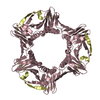
| ||||||||
| 3 | 
| ||||||||
| Unit cell |
|
- Components
Components
| #1: Protein | Mass: 28795.752 Da / Num. of mol.: 3 Source method: isolated from a genetically manipulated source Source: (gene. exp.)  Homo sapiens (human) / Gene: PCNA / Plasmid: pMCSG19 / Production host: Homo sapiens (human) / Gene: PCNA / Plasmid: pMCSG19 / Production host:  #2: Protein/peptide | Mass: 2763.233 Da / Num. of mol.: 3 / Fragment: 22 C TERMINAL RESIDUES (139 - 160) / Mutation: Y151F / Source method: obtained synthetically / Details: p21 peptide chemically synthesized / Source: (synth.)  Homo sapiens (human) / References: UniProt: P38936 Homo sapiens (human) / References: UniProt: P38936#3: Water | ChemComp-HOH / | Has protein modification | Y | |
|---|
-Experimental details
-Experiment
| Experiment | Method:  X-RAY DIFFRACTION / Number of used crystals: 1 X-RAY DIFFRACTION / Number of used crystals: 1 |
|---|
- Sample preparation
Sample preparation
| Crystal | Density Matthews: 2.58 Å3/Da / Density % sol: 52.34 % |
|---|---|
| Crystal grow | Temperature: 289 K / Method: vapor diffusion, sitting drop / pH: 7 Details: 0.08M strontium chloride hexahydrate, 0.02M magnesium chloride hexahydrate, 0.04M sodium cacodylate trihydrate (pH7.0), 20% v/v (+/-)-2-methyl-2,4-pentanediol and 0.012M spermine ...Details: 0.08M strontium chloride hexahydrate, 0.02M magnesium chloride hexahydrate, 0.04M sodium cacodylate trihydrate (pH7.0), 20% v/v (+/-)-2-methyl-2,4-pentanediol and 0.012M spermine tetrahydrochloride, final [PCNA] = 11.6mg/mL = 0.40mM, VAPOR DIFFUSION, SITTING DROP, temperature 289K |
-Data collection
| Diffraction | Mean temperature: 100 K | |||||||||||||||||||||
|---|---|---|---|---|---|---|---|---|---|---|---|---|---|---|---|---|---|---|---|---|---|---|
| Diffraction source | Source:  ROTATING ANODE / Type: RIGAKU MICROMAX-007 HF / Wavelength: 1.5418 Å ROTATING ANODE / Type: RIGAKU MICROMAX-007 HF / Wavelength: 1.5418 Å | |||||||||||||||||||||
| Detector | Type: RIGAKU RAXIS IV++ / Detector: IMAGE PLATE / Date: Jul 22, 2014 / Details: mirrors | |||||||||||||||||||||
| Radiation | Monochromator: Rigaku VariMax HF mirrors / Protocol: SINGLE WAVELENGTH / Monochromatic (M) / Laue (L): M / Scattering type: x-ray | |||||||||||||||||||||
| Radiation wavelength | Wavelength: 1.5418 Å / Relative weight: 1 | |||||||||||||||||||||
| Reflection twin | Operator: -h,-k,l / Fraction: 0.49 | |||||||||||||||||||||
| Reflection | Resolution: 2.0072→41.41 Å / Num. all: 63388 / Num. obs: 63388 / % possible obs: 100 % / Observed criterion σ(F): 0 / Observed criterion σ(I): 0 / Redundancy: 7.1 % / Biso Wilson estimate: 28.6 Å2 / Rmerge(I) obs: 0.055 / Rsym value: 0.055 / Net I/σ(I): 25 / Scaling rejects: 1365 | |||||||||||||||||||||
| Reflection shell | Diffraction-ID: 1
|
-Phasing
| Phasing | Method:  molecular replacement molecular replacement | |||||||||
|---|---|---|---|---|---|---|---|---|---|---|
| Phasing MR | Model details: Phaser MODE: MR_AUTO
|
- Processing
Processing
| Software |
| ||||||||||||||||||||||||||||||||||||||||||||||||||||||||||||||||||||||||||||||||||||||||||
|---|---|---|---|---|---|---|---|---|---|---|---|---|---|---|---|---|---|---|---|---|---|---|---|---|---|---|---|---|---|---|---|---|---|---|---|---|---|---|---|---|---|---|---|---|---|---|---|---|---|---|---|---|---|---|---|---|---|---|---|---|---|---|---|---|---|---|---|---|---|---|---|---|---|---|---|---|---|---|---|---|---|---|---|---|---|---|---|---|---|---|---|
| Refinement | Method to determine structure:  MOLECULAR REPLACEMENT MOLECULAR REPLACEMENTStarting model: 1AXC Resolution: 2.0072→39.272 Å / Isotropic thermal model: isotropic / Cross valid method: THROUGHOUT / σ(F): 1.98 / σ(I): 0 / Phase error: 20.77 / Stereochemistry target values: TWIN_LSQ_F
| ||||||||||||||||||||||||||||||||||||||||||||||||||||||||||||||||||||||||||||||||||||||||||
| Solvent computation | Shrinkage radii: 0.9 Å / VDW probe radii: 1.11 Å / Solvent model: FLAT BULK SOLVENT MODEL | ||||||||||||||||||||||||||||||||||||||||||||||||||||||||||||||||||||||||||||||||||||||||||
| Displacement parameters | Biso max: 47.97 Å2 / Biso mean: 26.152 Å2 / Biso min: 13.38 Å2 | ||||||||||||||||||||||||||||||||||||||||||||||||||||||||||||||||||||||||||||||||||||||||||
| Refinement step | Cycle: LAST / Resolution: 2.0072→39.272 Å
| ||||||||||||||||||||||||||||||||||||||||||||||||||||||||||||||||||||||||||||||||||||||||||
| Refine LS restraints |
| ||||||||||||||||||||||||||||||||||||||||||||||||||||||||||||||||||||||||||||||||||||||||||
| LS refinement shell | Refine-ID: X-RAY DIFFRACTION / Total num. of bins used: 14 / % reflection obs: 97 %
|
 Movie
Movie Controller
Controller





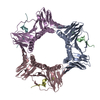


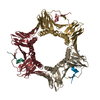

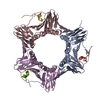
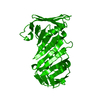
 PDBj
PDBj





















